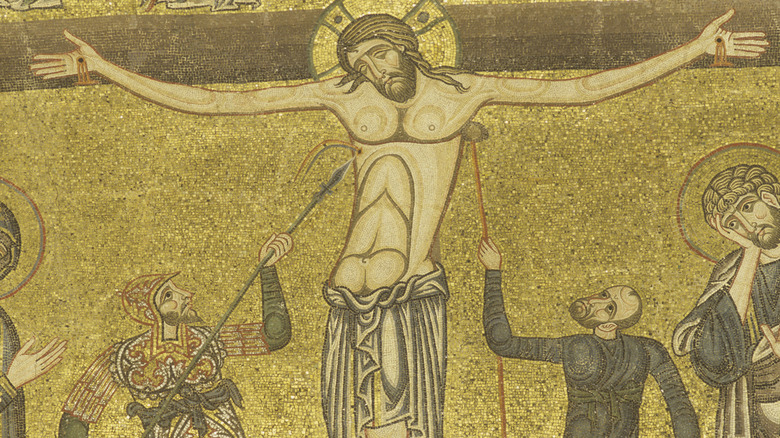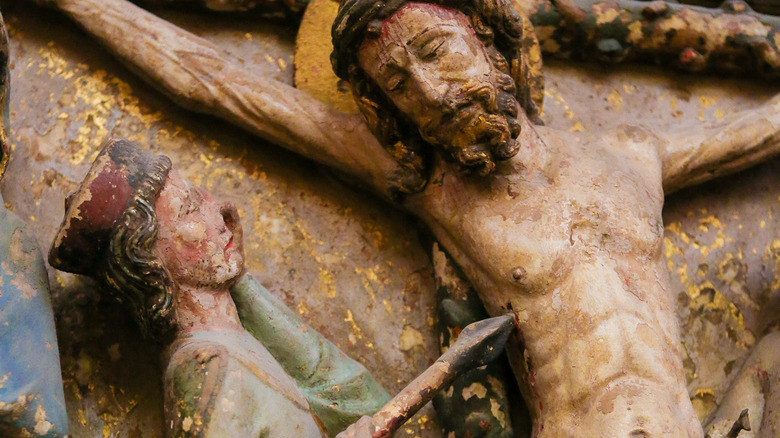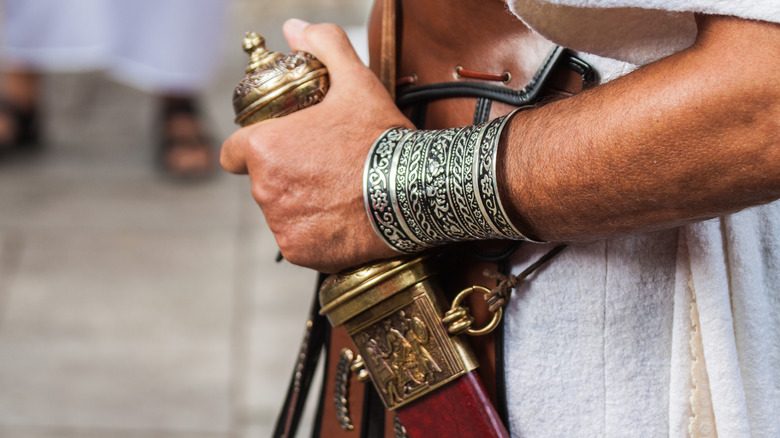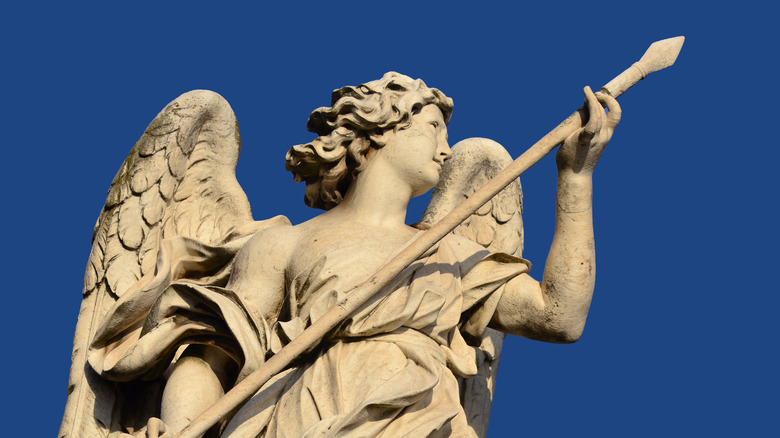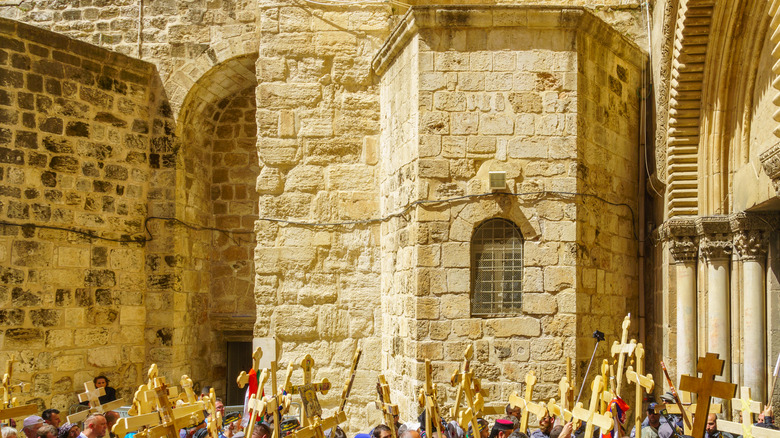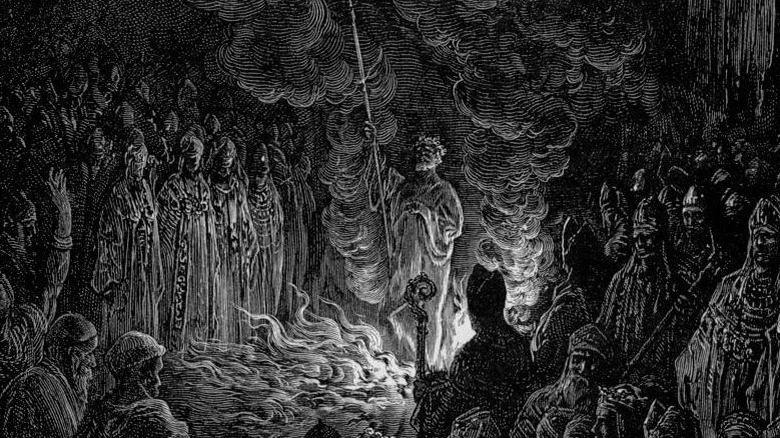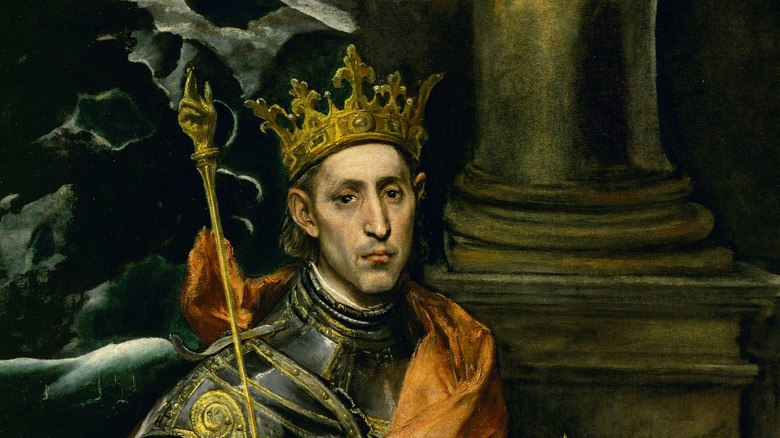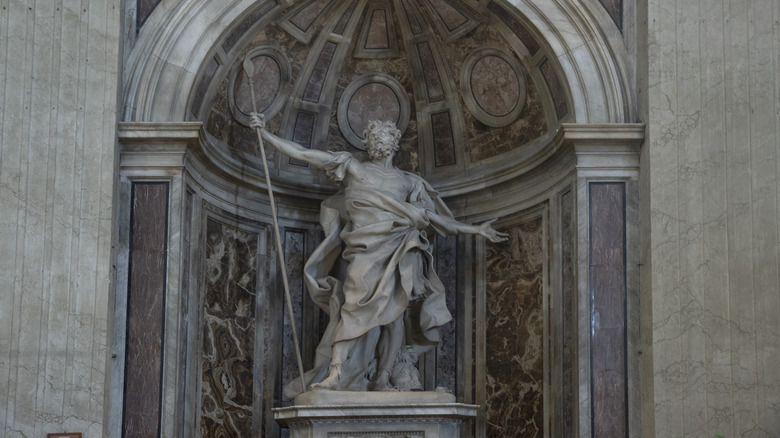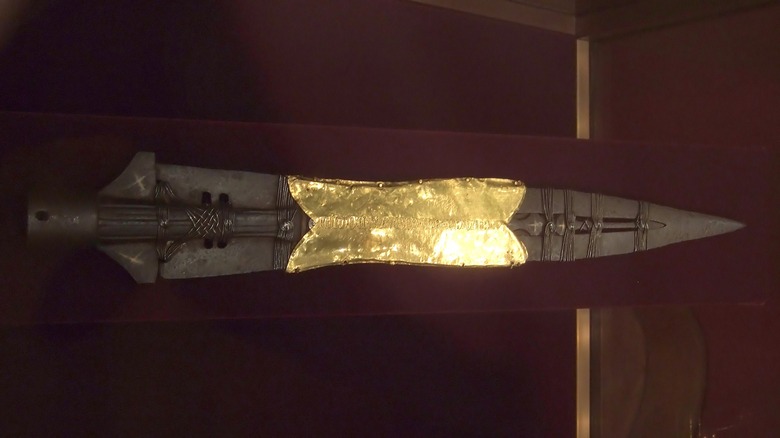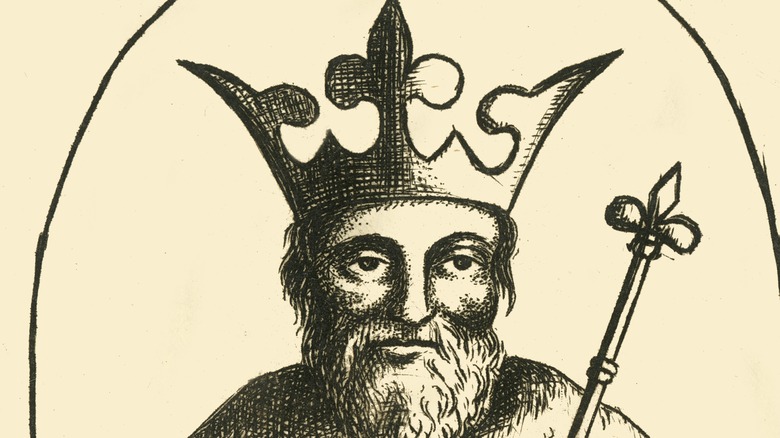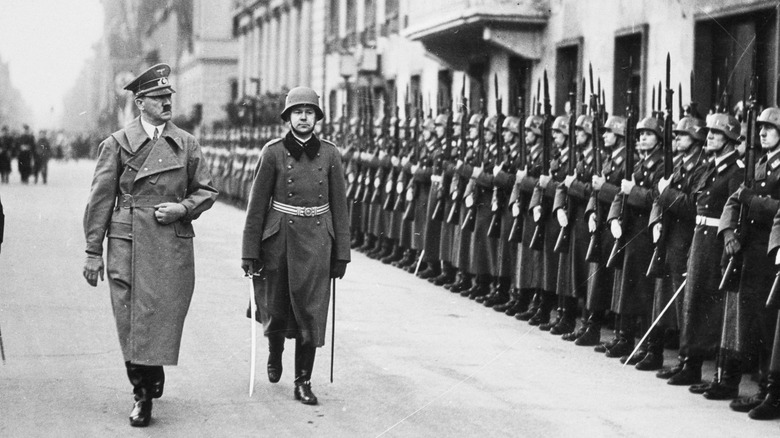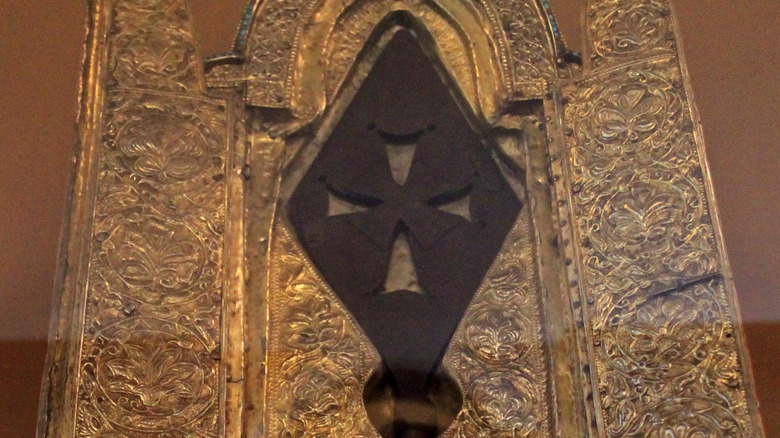The Mystery Of The Holy Lance Used In Jesus' Crucifixion
All religions have numerous artifacts that are said to have mysterious powers granted to them by divine will. The Crown of Thorns, the Ark of the Covenant, the Holy Standard of Muhammad, and even the remains of the Buddha himself are scattered around the world, inspiring the faithful and fueling tales of incredible powers that surround them. One of the most intriguing is the Holy Lance of Christianity. This object is one of the most prominent relics of that religion, being a central device in the story of Jesus Christ's crucifixion. Simply described, it is a spear which, according to Christian belief, was thrust by a Roman soldier into Jesus' side as he hung on the cross, to ensure he was dead.
Rumored to be an object of immense power, the Holy Lance has inspired the imaginations of the religious, the curious, the power-hungry, and the crackpot. What makes it even more enigmatic is that there are multiple artifacts that are purported to be the Holy Lance, but it is impossible to prove the veracity of these claims. Still, the Holy Lance ranks among the greatest of Christianity's relics, right up there with the True Cross and the Shroud of Turin.
The Gospel account
In canonical Christian scripture, the Holy Lance appears only in the Gospel of John. In this account, Jesus was crucified side-by-side with two thieves. Afterward, the Roman governor Pontius Pilate sent soldiers to break their legs with iron clubs, a practice known as "crurifragium." By doing so, the condemned person would no longer be able to support their weight on the cross, which would hasten their death. Pilate had ordered it so that the bodies could be taken down before the sabbath.
When the soldiers came, they broke the legs of the two thieves but found that Jesus was already dead. To make sure he was really deceased, the Gospel of John relates, "one soldier thrust his lance into his side, and immediately blood and water flowed out." Biblical analyses often point to the presence of water with the blood as miraculous and representative of baptism and sacrifice. Other interpretations suggest the "water" was likely bodily fluids that had built up in the sacs surrounding Christ's heart and lungs, released when the spear pierced his side.
There is no other mention of the Roman soldier's lance in Christian canon, and it is unclear what happened to the weapon afterward — which has left a good number of Christians through the centuries surmising.
Longinus
More information about the Holy Lance, or at least the wielder of it, comes from the apocryphal work "The Gospel of Nicodemus." In this account, which was written in the fourth or fifth century, the author identifies the wielder of the spear as a Roman centurion named Longinus. There are some Christian traditions which hold that Longinus was the same centurion from the canonical Gospel of Mark who exclaimed after Jesus' death, "Truly this man was the Son of God!"
In some narratives, Longinus was blind or had some other malady such as ophthalmia, which was miraculously cured when his eyes were touched by blood from the wound he'd inflicted in Jesus' side. The spear had now become the Holy Lance, and Longinus was changed. Some Christian traditions maintain that Longinus gave up his life as a soldier, converted to Christianity, and died as a martyr by beheading. He became Saint Longinus, with a feast day held on October 16.
The Spear of Destiny
It's inevitable that a holy relic that was used to pierce the body of one of the best-known religious figures in history is going to be credited with some supernatural powers. According to legend, both Charlemagne and Frederick Barbarossa were consistently victorious while they wielded the lance. It is for this alleged ability to guarantee victory, for good or evil, that the Holy Lance is also called "the Spear of Destiny." Most of these legends additionally state that when someone who wields the lance loses it, death quickly follows. Both Charlemagne and Frederick Barbarossa supposedly died shortly after dropping or losing the lance.
Another power ascribed to the Holy Lance is one of healing. This figures most prominently in lore concerning the Holy Grail, a cup that was used to catch the blood of Jesus at the crucifixion. In these stories, the grail and the lance are paired. In Sir Thomas Malory's 15th-century compendium of tales of King Arthur, "Le Morte D'Arthur," he tells how in Arthurian legend, the lance came to symbolize the very life force of the earth. In one central tale, the knight Balin wounds the keeper of the grail and the spear (known as the Fisher King). The unholy act causes the land to waste away, to be righted only when the Fisher King is healed by the Holy Lance.
A dodgy history
The history of the Holy Lance is murky, since it's based on religious texts, scraps of evidence, and folklore. One tradition claims that Joseph of Arimathea, who was in charge of Jesus' burial, obtained the Holy Lance and the Holy Grail. From that point, the Holy Lance seems to vanish until about A.D. 570, when a writing attributed to an individual known as "the Piacenza Pilgrim" details how the writer, on pilgrimage to the Holy Land, sees the lance in the Basilica of Zion.
From that point, the history of the Holy Lance becomes even cloudier. Around A.D. 615, Jerusalem was captured by the Persians, and somewhere in the confusion the point of the lance was broken off and taken to the Hagia Sophia in Constantinople, where it was incorporated into an icon. The second part of the lance is mentioned by the historian Arculpus, who saw it sometime around A.D. 670, after the Byzantine Empire had retaken Jerusalem. From there, the lance drops out of the historical record again, and these two pieces then multiply into several artifacts that have been presented as the true Holy Lance.
Peter Bartholomew's Holy Lance
One of the most dramatic stories in Holy Lance lore is that of the French pilgrim Peter Bartholomew. During the First Crusade (1095-1102) he claimed to have visions of Saint Andrew, who revealed to him the location of the lance. When he recounted these visions to the Crusade leaders, a papal representative was skeptical but regiment leader Count Raymond of Toulouse was not. His willingness to believe Bartholomew may be understandable; according to an account written by a priest who participated in the First Crusade, Christian forces were besieged at Antioch and had reached a new low. There were military setbacks, and the troops staved off hunger by eating leaves, grapevines, and dried animal skins.
Bartholomew insisted the Holy Lance was buried in the floor of Antioch's cathedral. Workers spent a day digging but produced nothing. Finally, Bartholomew jumped into the hole and dug up a rusty iron rod. While the Crusade's commanders were dubious, it nevertheless produced the morale boost needed to break the siege, and many Crusaders began looking to Peter as a spiritual leader. However, the frequency of his supposed visions increased the belief that the whole thing was a charade. To prove he'd found the true Holy Lance, Bartholomew submitted to an ordeal of fire in which two pyres were lit ablaze with a small space between them. If Bartholomew was telling the truth, he would live after walking through the fires with the lance. He died of the severe burns he sustained.
The French Holy Lance
It is believed that, at some point, the Holy Lance had most likely been split into two relics: the tip and the much larger shaft. According to a seventh-century Byzantine text known as the "Chronicon Paschale," the tip was likely brought to Constantinople, where it was set within an icon. Fast forward a few centuries to the Fourth Crusade, when the Crusaders, instead of fighting Islamic forces, chose to sack Constantinople and establish their own Latin Empire. This empire lasted until 1261, when the emperor Baldwin II was ousted by the Byzantines. But before that, Baldwin had gotten his hands on the spear's tip. He sold it along with other relics to King Louis IX of France.
The French King, who was sainted after death for his piety, placed the relic at the Church of Sainte Chapelle. It remained there for centuries until the French Revolution, when it was moved to the Bibliotheque Nationale in Paris because of the civic tumult. Sadly, the tip vanished sometime after the move. Its whereabouts are unknown to this day.
The Vatican's Holy Lance
One piece of the spear can be traced fairly easily. In 1357, Sir John Mandeville wrote that he saw objects described as the blade of the Holy Lance in both Paris and Constantinople, with the one in Constantinople being the larger of the two.
The Constantinople relic then came into possession of the Ottoman Empire after it conquered Constantinople in 1453. However, the Ottoman Turks did not hold onto the object long; in 1492 the Sultan Bajazet sent the relic to Rome as part of a diplomatic entreaty with Pope Innocent VIII, who was holding the sultan's brother prisoner.
This object is now held under the Dome of St. Peter's Basilica, but the Catholic Church does not claim it to be the authentic Holy Lance, partly because of conflicting claims of other Holy Lances. To complicate matters further, it is unclear if the item found by Peter Bartholomew in Antioch is the one now held in the Vatican or if it is another one that was also held in Constantinople. However, in the 18th century, Pope Benedict XIV concluded that the relic in Rome matched the piece in Paris. He had an exact drawing made of the Paris relic, compared it to the one in St. Peter's, and became convinced the two pieces had come from the same object. He declared the Antioch lance of Peter Bartholomew a fake even though there are lingering questions as to whether the one in the Catholic Church's possession is that same artifact.
The Viennese Holy Lance
The next contender for the true Holy Lance can be found in the Hofburg Palace in Vienna, Austria. Legend connects this version of the Holy Lance to the Emperor Constantine, who supposedly commissioned the piece after his mother found three nails that were believed to be relics from the crucifixion. The emperor supposedly took two to incorporate into his crown and horse bridle. The third was incorporated into the lance. Other lore states that this lance belonged to St. Maurice, a leader of the Theban legion who became a martyr after he refused to kill Christians. In any event, this lance, as it is known today, is described by Stephen Klimczuk's "Secret Places, Hidden Sanctuaries" as a piece of metal with a purported nail of the crucifixion held to it by gold, silver, and copper thread.
Despite the muddled history, this spear became closely associated with the power and prestige of monarchy. It is believed it ended up in the possession of Charlemagne and then subsequent Holy Roman emperors, eventually finding its way to Nuremberg. When the Holy Roman emperorship passed to monarchs in Austria, the relic was relocated to Vienna.
[Featured image by Aiwok via Wikimedia Commons | Cropped and scaled | CC BY-SA 3.0]
The Holy Lance English holiday
One part of the story of the Vienna Holy Lance is that it may have temporarily made its way to England. The medieval chronicler William of Malmesbury states in his account that the spear of Charlemagne (i.e. the Holy Lance) and other holy and priceless gifts were given to the Anglo-Saxon king Athelstan by Hugh the Great in A.D. 926 in order to secure a marriage with Athelstan's sister.
Some sources, including the Catholic Encyclopedia, refute this story, chalking it up to a "misconception." However, this same source also misidentifies Hugh the Great as his son Hugh Capet, who was born in 938 — several years after the exchange supposedly happened — adding to the confusion.
After this point, it is unclear what happened to this spear (if it existed at all), but some of the more fanciful sources indicate it may have passed into the hands of King Otto I of Germany (aka Otto the Great) as partial dowry for the marriage to his half-sister Edith in 939. However, this does not seem to be the case, since more reliable analyses, such as the scholarly work "Pilgrimage and Pogrom" by Mitchell B. Merback, indicate that the lance passed to Otto directly from his father, thus connecting the artifact to the German throne. All this reinforces the cryptic nature of Holy Lance history and lore, which is further emphasized by the supposed relationship between the Spear of Destiny and a certain up-and-coming autocrat in the early 20th century.
Hitler and the Holy Lance
To those who believe, the Holy Lance is an artifact of great power. Therefore, it should come as no surprise that there are claims that history's dictator of dictators, Adolf Hitler, was interested in the spear. The chief claimant is Trevor Ravenscroft, the author of the controversial 1972 book "The Spear of Destiny," who wrote that Hitler saw the lance held in Vienna as a "talisman of power" and that it was the source of his "ambitions to conquer the world."
Thus, after Hitler came to power and forced the incorporation of Austria into Germany in 1938, he confiscated the treasures of the Hapsburg dynasty, which included the spear. The relic was then sent to its old home of Nuremberg, where it was kept at St. Katherine's Church. Hitler went on to wage the deadliest war in world history, but on April 30, 1945, he died by suicide. Legend holds that only a few hours before, American soldiers had captured the Spear of Destiny, supposedly depriving Hitler of its powers.
Sounds great, but the story doesn't hold up to scrutiny and has been widely debunked. A full breakdown of Ravenscroft's dubious research is summarized by History of War. In addition, the Smithsonian debunks Ravenscroft's version of America's recovery of the spear, explaining that U.S. troops took possession in 1946, months after Hitler died. Regrettably, even though Ravenscroft's dodgy research was published more than 50 years ago, the story is still being picked up by numerous media outlets.
The Armenian Holy Lance
The next candidate for the title of the real Holy Lance can be found in Armenia as a holy relic of the Armenian Church. According to lore, St. Thaddeus or even Longinus himself brought the spear to Armenia in the first century. Sources from late antiquity concur that the relic was indeed there, but confusion still abounds since there was already a multiplicity of lances.
The lance found a home in the monastery of Geghard (also spelled Keghart), where a reliquary was built for it in 1268. Like its brethren, this lance was also purportedly imbued with magic powers. For example, the Armenian Church relates how in 1798, the lance was lent to the king of the realm of Georgia to heal those afflicted by a plague and returned afterward. This lance, however, is shaped a bit differently than a spear. Its tip isn't sharp and it's and shaped more like a diamond, leading some to question the veracity of this particular claim. Today, this Holy Lance may be found in Vagharshapat.
It continues to fascinate
The Holy Lance, with its contorted history, purported powers, and enduring mystery, continues to be a source of fascination. While it doesn't have the same recognition as the Ark of the Covenant, it still has a commendable presence in popular culture. There seems to be an infinite number of stories which have used the lance as a central plot MacGuffin. For example, the 2005 film "Constantine" starring Keanu Reeves featured the Spear of Destiny, which was found by a scavenger in the ruins of a church, wrapped in a Nazi flag.
The Holy Lance is also featured in numerous books and other movies. Even Indiana Jones has made a foray to find the lance before the Nazis do in a graphic novel titled "Indiana Jones and the Spear of Destiny." Nazis also are featured prominently in the classic computer game "Wolfenstein 3-D: Spear of Destiny," in which the protagonist has to get the spear from the bad guys.
With such appearances, it is apparent that the Holy Lance will continue to be source of enduring mysteries — and conspiracy theories — for ages yet to come.
